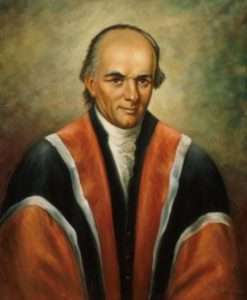The Volokh Conspiracy
Mostly law professors | Sometimes contrarian | Often libertarian | Always independent
Today in Supreme Court History: April 21, 1800
4/21/1800: Justice Alfred Moore takes judicial oath.

Editor's Note: We invite comments and request that they be civil and on-topic. We do not moderate or assume any responsibility for comments, which are owned by the readers who post them. Comments do not represent the views of Reason.com or Reason Foundation. We reserve the right to delete any comment for any reason at any time. Comments may only be edited within 5 minutes of posting. Report abuses.
Please to post comments




City of Austin, Texas v. Reagan Nat’l Advertising of Austin, LLC, 596 U.S. 61 (decided April 21, 2022): City ordinance restricting billboards that (like most billboards) are not on land they are advertising for is content-neutral and subject to “intermediate” First Amendment scrutiny; remanded to Fifth Circuit (which then upheld the ordinance, 64 F.4th 287)
United States v. Vaello Madero, 596 U.S. 159 (decided April 21, 2022): not denial of Equal Protection to deny SSI benefits to Puerto Ricans; they don’t pay taxes for it (New Yorker ordered to return benefits awarded after he moved to P.R.)
Jerman v. Carlisle, McNellie, Rini, Kramer & Ulrich LPA, 559 U.S. 573 (decided April 21, 2010): “bona fide error” defense to liability under Fair Debt Collection Practices Act does not apply to mistake of law (here, an incorrectly worded notice from a law firm trying to collect on a mortgage)
United States v. Haggar Apparel Co., 526 U.S. 380 (decided April 21, 1999): Chevron deference (to an agency’s reasonable interpretation of a statute) applied to regulation stating that chemical treatment during assembly (here, men’s trousers) removes imported clothing from duty exemption for articles fabricated here but merely assembled abroad
CSX Transportation, Inc. v. Easterwood, 507 U.S. 658 (decided April 21, 1993): can’t sue train for going unreasonably fast under the circumstances if it was under speed limit set by federal regulation (now that’s what I call preemption!)
United States v. Alaska, 503 U.S. 569 (decided April 21, 1992): Another Chevron deference case, wherein Alaska, whose highways are not much use, tried to improve its Nome port which in the process would extend Alaska’s border by accretion. The Court upholds the decision of the Secretary of the Army (whose Corps of Engineers would be doing the work) to condition the permit on a waiver of all claims to the new land.
Tison v. Arizona, 481 U.S. 137 (decided April 21, 1987): Under the felony-murder rule, a killing in the process of committing a felony is murder, not manslaughter (cf. the misdemeanor-manslaughter rule), even if the defendant did not do the actual killing. Here the Court upholds the rule against Eighth Amendment attack so long as participation in felony is “major” and “reckless indifference” to human life. (Defendant had helped steal car after escaping prison, occupants were shot by co-defendant.)
Larson v. Valente, 456 U.S. 228 (decided April 21, 1982): denial of Equal Protection to restrict charitable solicitation permits given to organizations funded more than 50% by nonmembers
Rosales-Lopez v. United States, 451 U.S. 182 (decided April 21, 1981): at jury selection in violent crime case federal judge, upon request, must inquire into jurors’ racial prejudices, particularly if defendant and victim were different races (here, it was harmless error to deny request)
Cassirer v. Thyssen-Bornemisza Collection Foundation, 596 U.S. 107 (decided April 21, 2022): Foreign Sovereign Immunities Act claim against Spanish art foundation (for holding family’s painting extorted by Nazis) was based on state law, so law of forum state (California) applied, not federal common law (the opinion contains the painting, Pissaro’s 1897 “Rue Saint-Honore in the Afternoon, Effect of Rain”, and a photo of it hanging in plaintiff’s grandmother’s Berlin home)
Tison v. Arizona arose out of a prison break involving three brothers (one of whom was killed during the extended flight afterwards) and two murderers (the father died from exposure; the other murderer was caught & executed).
The case involves the two brothers who claimed that they were getting water while the family was being shot. They took weapons to help the breakout from prison and took part in the flight. The opinion was 5-4.
Ultimately, their sentence was reduced to life in prison. They are still alive and in their 60s.
https://www.williamrempel.com/tison-boys-at-the-supreme-court
Rick, then 19, and Raymond, then 18, along with a third brother, Donald, helped their convicted killer father Gary and another murderer, Randy Greenawalt, escape from the state prison in Florence, Ariz., on July 30, 1978.
https://www.upi.com/Archives/1992/09/11/Brothers-finally-free-from-death-sentence-after-13-years/4398716184000/
Thanks
[deleted — accidental double post]
Dan, I'm getting senile. I can't remember the name you used to post under and it's nagging me for some reason. Could you please help me out?
captcrisis
Thanks for the question — I’m flattered. Can I help you find something?
No, that was it. Sometimes a brain cell blows out and I obsess for days about the missing memory whether it matters or not. I once spent nearly a week trying to remember Carlos Baerga, a former Met second baseman.
At only four feet five inches tall, Justice Alfred Moore was the shortest justice to ever sit on the Supreme Court.
Like other largely forgotten early justices, Moore had an impressive biography, including Revolutionary War military service, state governmental service (including attorney general and judge), and a two-time U.S. Senate candidate.
As attorney general, he argued a case that became an early precedent for judicial review. He was also a major slave owner.
https://northcarolinahistory.org/encyclopedia/bayard-v-singleton/
He was also a founder and trustee of the University of North Carolina at Chapel Hill.
Justice Moore only wrote one opinion in the notable Bas v. Tingy case, involving the war power. He did not take part in Marbury v. Madison and left the Court for reasons of health. He was replaced by William Johnson.
An early case of an unexpected vacancy leaving an opening for a president to have a significant opportunity.
"only four feet five"
Doing Moore with less.